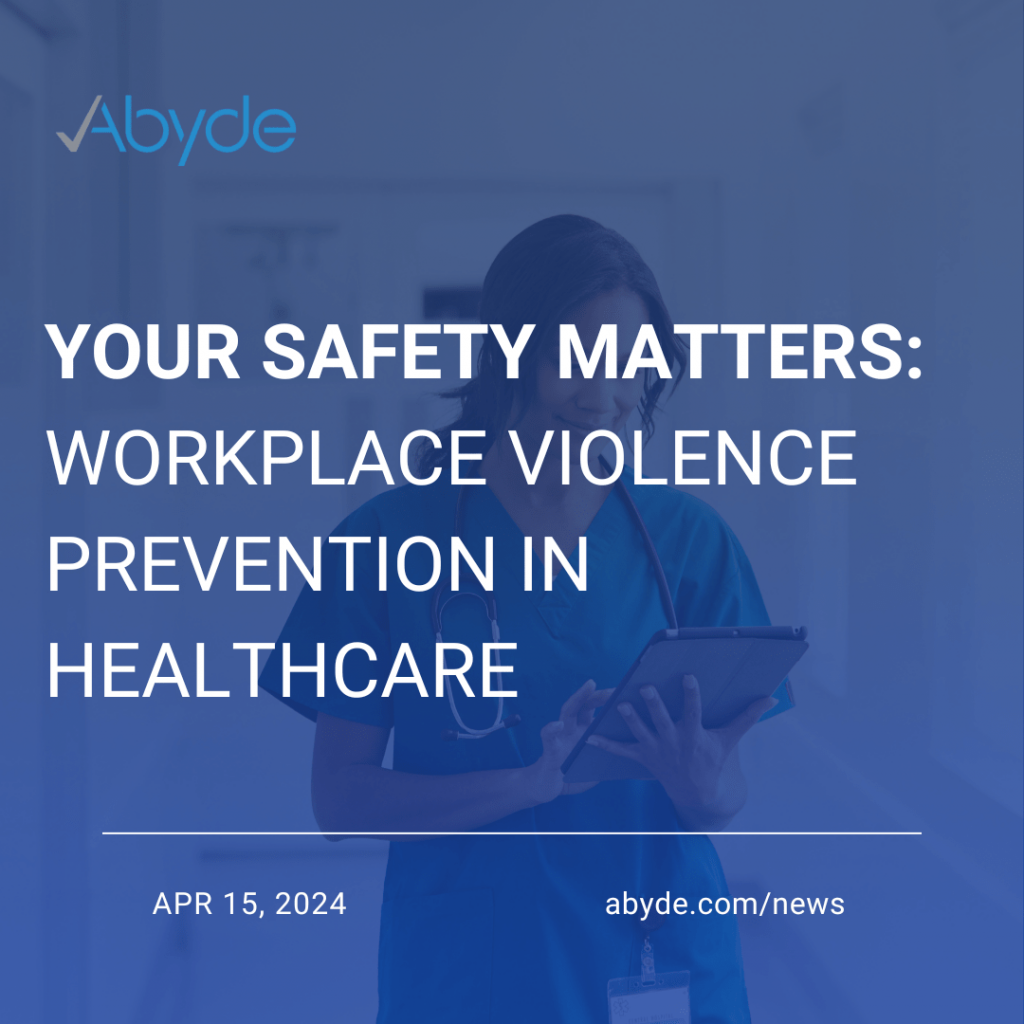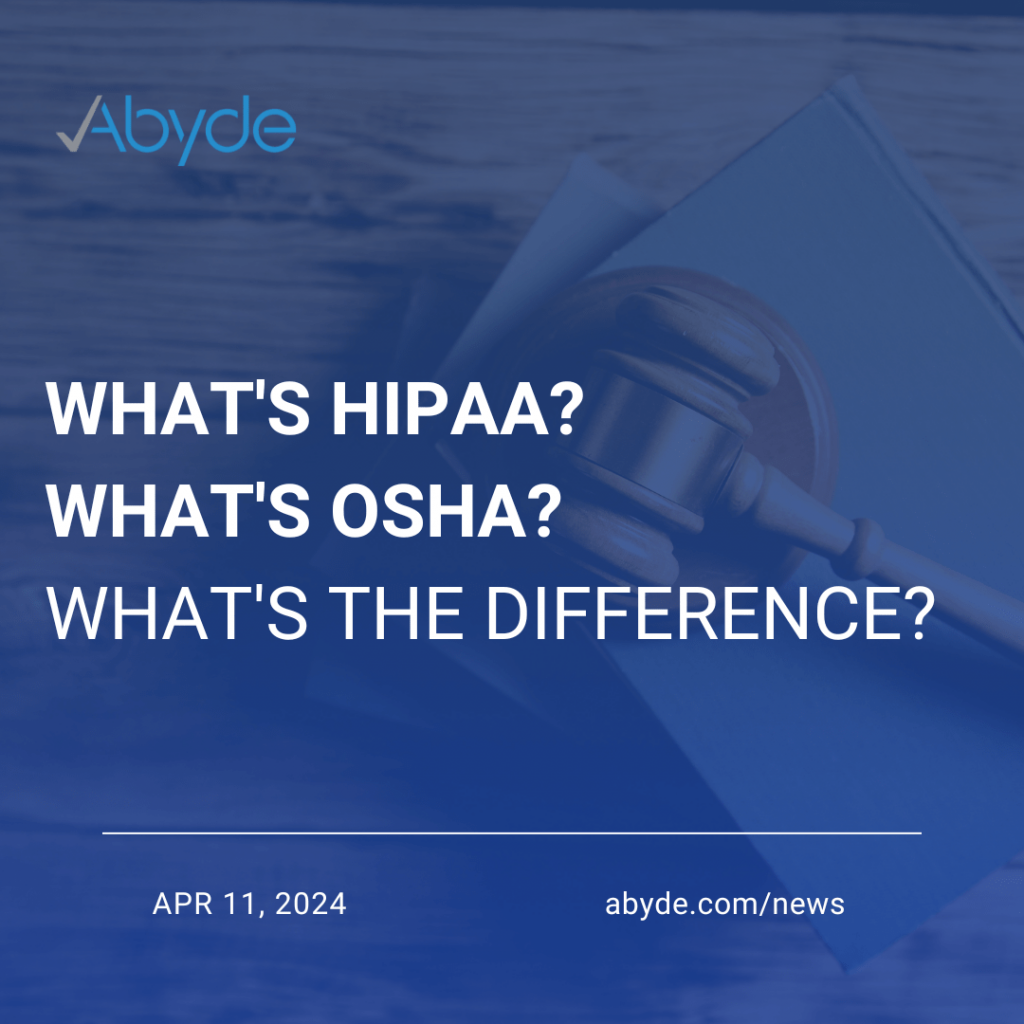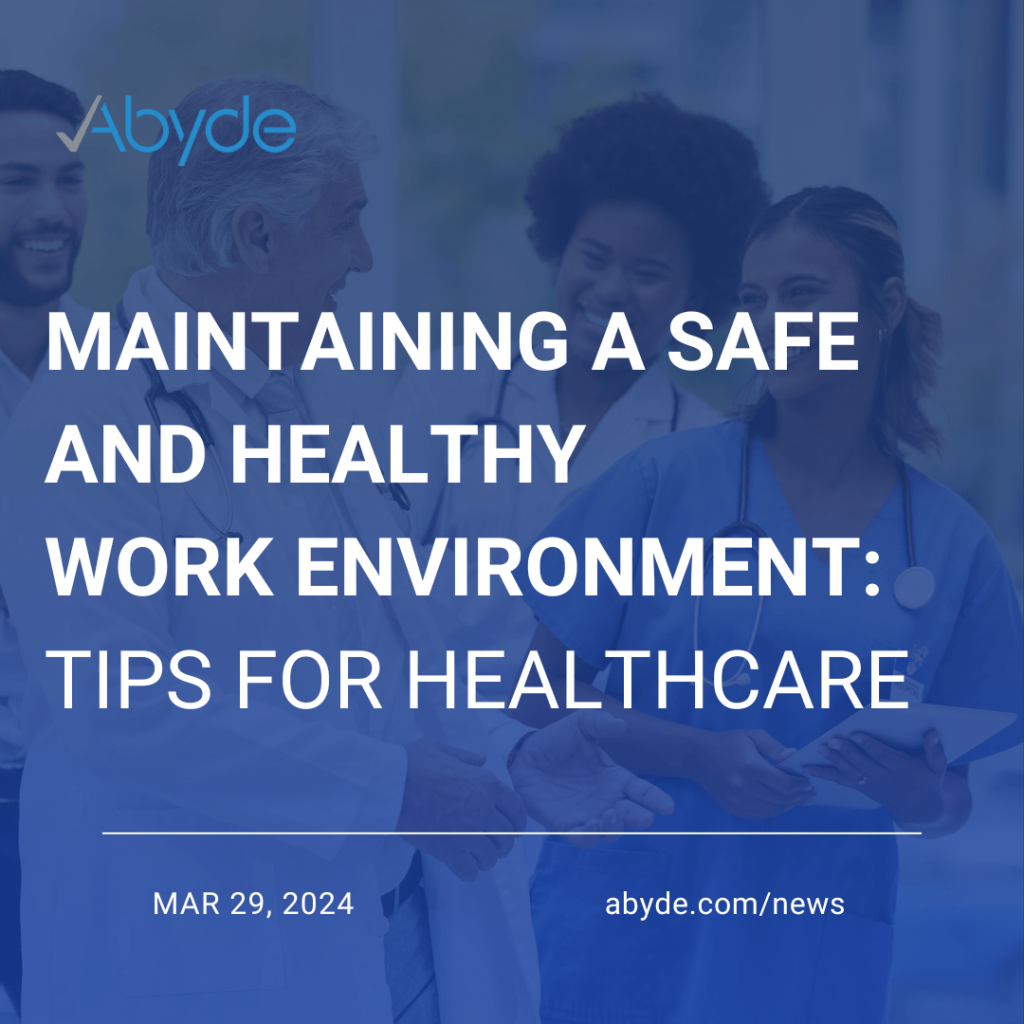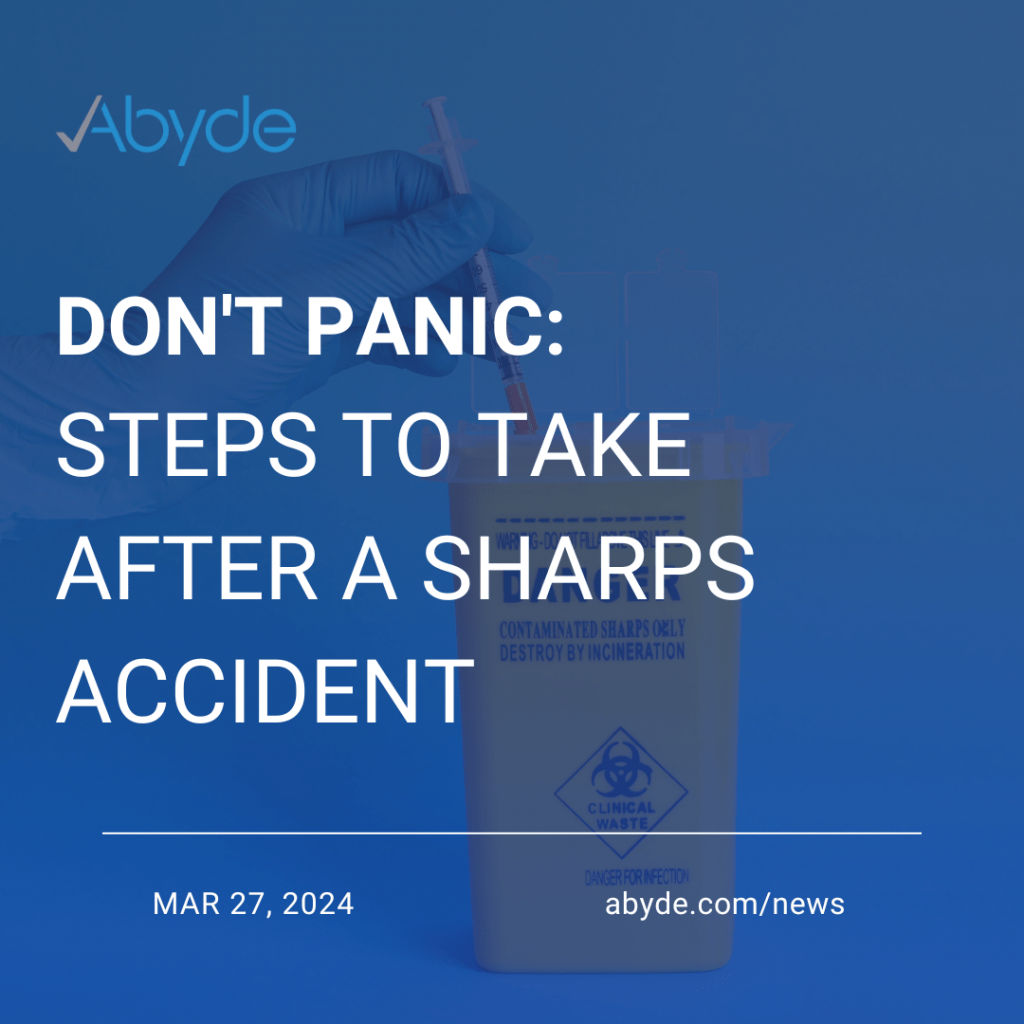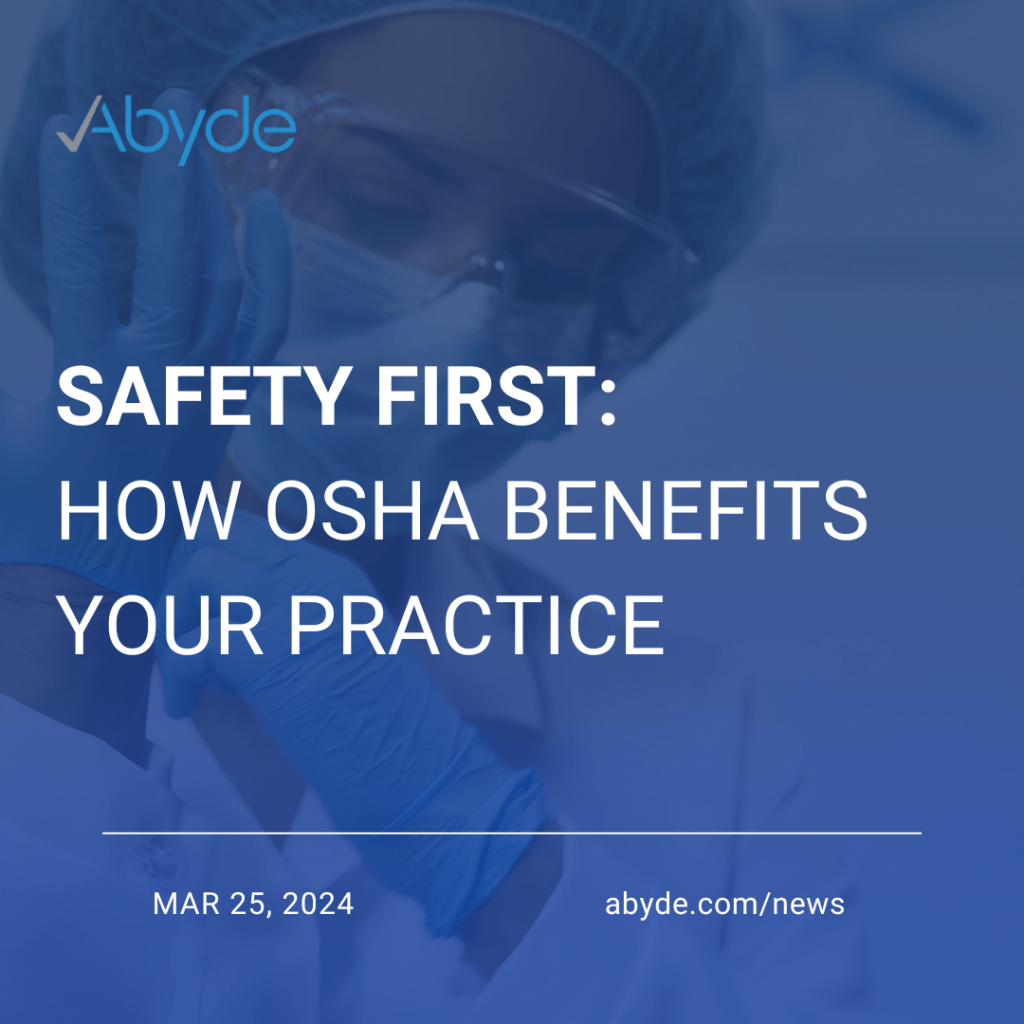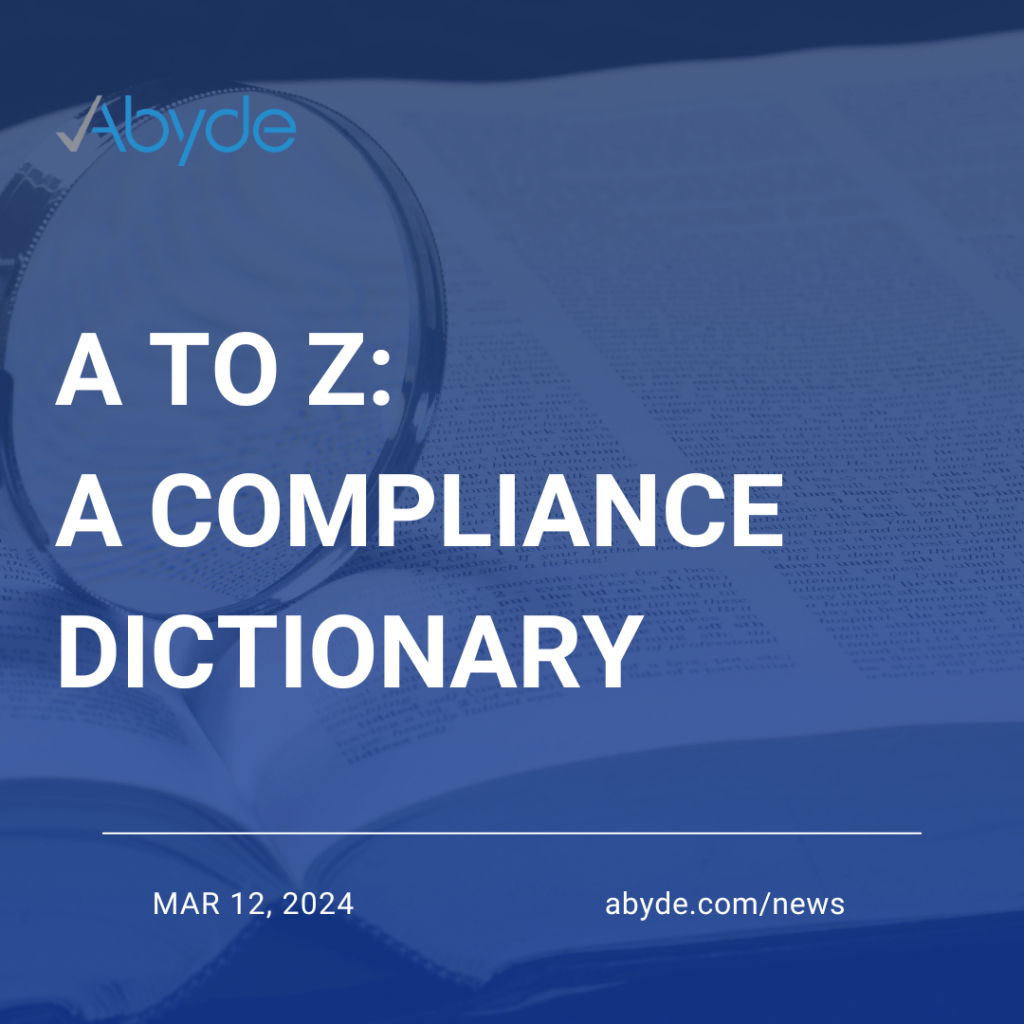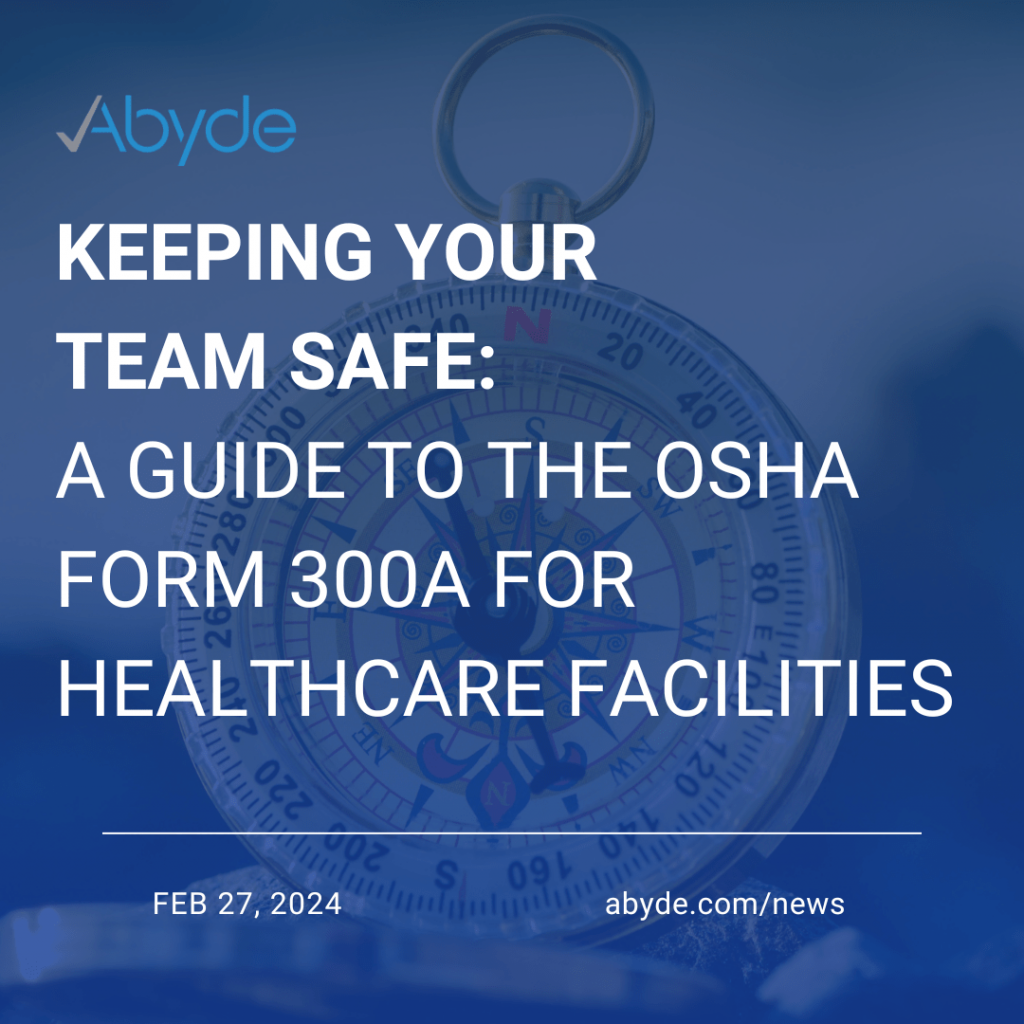April 16, 2024 Happy Toothsday! Okay, okay, yes, we know that was bad. Regardless, we hope you’re having a lovely beginning of the week. Working in dentistry can be very rewarding, You know that confident feeling of rocking a fantastic smile? In dentistry, you get to create that feeling for people every day. However, dentistry comes with challenges, like working with sharps daily and the possible exposure to bloodborne pathogens. Here at Abyde, we’re all about prevention and safety. Today, we’re jumping right into promoting safety in dental offices. By following the right procedures, you can focus on what’s important: creating dazzling smiles! Gear Up for Grins When working at your practice, having the proper Personal Protective Equipment (PPE) is vital. PPE encompasses all the protective gear you need to wear to ensure your safety while working with patients. This includes equipment like: While your masks and gloves might not be the most fashionable statement pieces, by rocking the correct PPE, you can minimize exposure to germs and other dental hazards, keeping you safe. Let’s face it (pun intended!), dentistry can get a little…messy at times. That’s where PPE comes in! Face shields and glasses act as your splash guards, keeping your eyes protected from any flying fluids or debris. Gloves also minimize contact, keeping your hands covered when delivering exceptional patient care. This way, you can focus on creating beautiful smiles without worrying about exposure. Syringe Savvy Using sharps is part of the dental world. That’s why we recommend the latest and safest tools. Think of it this way: those fancy safety features on your dental devices aren’t just bells and whistles – they’re game-changers! Sure, change can be a bit daunting, but these innovations are designed to make your practice safer, smoother, and ultimately, more awesome. Some of the common safety tools include: Bite-sized Learning When protecting your staff, training is key. With excellent training, your staff can be equipped with the knowledge they need to be safe. This includes mastering the proper steps for sharps and bloodborne pathogens, two of the most common safety issues in a dentist’s office. These situations can be tricky, but with the proper training, your team can conquer any challenge with ease. How Abyde Can Help We know that paperwork and regulations can feel like a cavity that just won’t quit. That’s why we make it simple. Abyde is a software solution that makes compliance easy. With Abyde, we offer a variety of resources to make compliance a breeze, including training on everything you need for dental compliance. To learn more about what it takes to be compliant in your dental practice, email us at info@abyde.com and schedule a consultation here.
Your Safety Matters: Workplace Violence Prevention in Healthcare
April 15, 2024 Hi everyone! We hope you had a nice weekend! We’re starting this week with a heavier, but necessary article. We ALL deserve to feel safe and comfortable when at work – no, ifs, ands, or buts. This is especially true for our healthcare workers. It’s a stressful job, and on top of the pressure, they shouldn’t have to worry about violence or unsafe working conditions. Unfortunately, this is not the case. Workplace violence is especially common in healthcare, disproportionately affecting healthcare workers. For example, workplace violence is FIVE more times as likely to occur in private healthcare practices and social assistance programs than in any other industry sector. This is unacceptable. But, hey, here’s a half-glass-full mindset! There’s always a way to change that! We need to create a better workplace for our healthcare employees. Today, we’re diving into the best ways to build a culture of safety and compliance in your practice, so your staff feels empowered and safe. Leading the Charge To ensure a team feels safe and secure in the workplace, their leaders must establish a culture of compliance. While we talk about a culture of compliance often, what does that mean? From leadership, means guiding and ensuring the safety of employees, having clear policies in place, providing worthwhile training, and much more. This behavior is not just after an incident, but continuously, cultivating an environment where staff feels safe and supported. All employees must feel heard and supported in the workplace, encouraging open communication about their experiences and what can be done to make the workplace even better. Employees are the heart of any healthcare setting, and their safety is paramount. To empower them to feel secure, clear reporting methods are crucial. This includes offering multiple channels, like a confidential hotline or online portal, to report any situation that raises a red flag. But safety isn’t a one-time fix. It’s a continuous journey that requires ongoing commitment from leadership. By incorporating these elements, leadership fosters a culture of compliance where staff feels safe and supported at work, knowing their concerns are heard and acted upon, ultimately creating a safer work environment for everyone. Violence? Yeah, No, Gotta Go In part of implementing a culture of compliance, ensure all staff is aware that there is a zero-tolerance policy for violence in the workplace. This policy encompasses all employees, patients, visitors, and in general, anyone who comes into contact with a practice’s employees. This zero-tolerance policy covers everything that goes beyond respectful interactions. By establishing a zero-tolerance policy, you protect your employees. By making clear consequences for workplace violence, your staff can focus on what they do best: healing others. How Abyde Can Help Workplace violence in healthcare is unfortunately an epidemic in the field. For instance, 64% of clinicians have felt physically unsafe at work. At Abyde, we believe a strong culture of compliance shouldn’t be a burden. That’s why we offer revolutionary compliance software that simplifies the process for everyone. With Abyde, all employees become active participants in creating a safe and secure work environment. By making compliance easier, Abyde empowers your staff with the knowledge and resources they need to be successful. This translates to a more confident and engaged workforce. No one deserves to feel unsafe at work, and with Abyde, we’re all taking a step towards a safer, more positive work environment for everyone. Get started on building a culture of compliance today! Email info@abyde.com and schedule a consultation here.
What’s HIPAA? What’s OSHA? What’s the Difference?
April 11, 2024 Now, when you work in healthcare, you’re not only responsible for the care of patients but also a slew of compliance regulations. Sometimes, it can be confusing and overwhelming. The world of healthcare throws a whole lot of acronyms and regulations your way. HIPAA? OSHA? What do they mean? Well, don’t worry, this isn’t a pop quiz. We’re here to shed some light on these common compliance regulations and what they mean for your practice or business. HIPAA: Hip Hip Hooray for Patient Privacy First, if you are a Covered Entity (CE) or Business Associate (BA), you have most likely heard of HIPAA. HIPAA, or the Health Insurance Portability and Accountability Act guides how the Protected Health Information (PHI) of patients must be secure and safe. HIPAA also establishes the standards for how this sensitive health information is exchanged. HIPAA was signed into law by Bill Clinton almost 30 years ago, in 1996. HIPAA was established as we made major technological strides. As technology continued to advance and was making its way into healthcare, with ePHI, or electronic Protected Health Information, it was time for legislation to be put in place. HIPAA is composed of three key components: the Privacy Rule, the Security Rule, and the Breach Notification Rule. There is also the HIPAA Omnibus Rule of 2013, which expanded the definition of Business Associates, encompassing all that create, receive, or transport PHI on behalf of a Covered Entity. HIPAA regulations are enforced by the Office For Civil Rights (OCR), under the HHS. HIPAA violations can incur major monetary penalties and monitoring of a practice or business by the government. These fines can cost millions of dollars, so your practice must be HIPAA compliant! OSHA: Oh shucks, Little ol’ me? With OSHA in Healthcare, we flip the script from HIPAA. Instead of focusing on patients, it’s about you! Healthcare workers and Business Associates, or under OSHA, known as third-party vendors, falling under Joint Responsibility, are protected by this federal legislation. OSHA, or the Occupational Safety and Health Administration was established when the OSH ACT was signed by Richard Nixon on December 29, 1970. The administration itself was enacted as a result of this legislation, opening April 28, 1971. This workers’ rights legislation came at a time when there were limited protections for employees, and this federal law granted protection to employees from all industries. OSHA encompasses much more than just healthcare, providing legislation and regulation to every industry you can think of: from factories to construction sites, to even offices. OSHA is very prevalent in healthcare, ensuring employees feel safe and protected in their practice. For instance, common OSHA healthcare concerns include proper PPE (Personal Protective Equipment), handling sharps, and potential exposure to bloodborne pathogens. Different from HIPAA, since OSHA is an administration rather than just a law, OSHA enforces its regulations. OSHA enforcement can also cost a pretty penny: costing thousands per violation, with repeated violations going up to over $160,000. How Abyde Can Help Well, that was a lot of compliance talk! HIPAA and OSHA are two very important compliance regulations that protect both patients and employees. While compliance might feel like an added responsibility, it’s vital for the protection and safety of everyone. Without HIPAA and OSHA, patients’ privacy wouldn’t be protected and employees wouldn’t have safety and health standards in the workplace! At Abyde, we simplify the compliance process, offering HIPAA and OSHA solutions. We even make it easy. We know that this compliance jargon and rules can be stressful, so our mission is to have practices and businesses Never Stress Over Compliance Again. We offer streamlined documentation, dynamically generated for your organization. We turned the daunting Security Risk Analysis or Facility Risk Assessment for OSHA into a minutes-long questionnaire. We also provide entertaining training that equips employees with the knowledge they need. Abyde offers many more resources to keep you on your compliance A-game. To learn more about what you need for compliance, email us at info@abyde.com and schedule a consultation here for Covered Entities and here for Business Associates.
Maintaining a Safe and Healthy Work Environment: Tips for Healthcare
March 29, 2024 Happy Friday! Cheers to another work week conquered. When at work, we all deserve to feel safe and healthy. Healthcare workers face a unique challenge. You juggle patient care like a pro, but keeping yourself healthy can feel like another battle entirely. Well, we’re here to give you some tips on maintaining a safe and healthy work environment. Safety First! First and foremost, ensure you’re all trained and aware of what you must do to be safe. With software like Abyde, we make training fun! Our entertaining OSHA training challenges the status quo, with interactive activities and videos that can be done at your own pace, keeping your practice open and not in boring training sessions. Get stylish! Personal Protective Equipment (PPE) is required in the workplace, making sure you all have the, maybe not so fashionable, but functional protective gear to handle any situation in healthcare. For instance, gloves are a MUST, keeping healthcare workers and patients safe from germs. Like a dad on a family vacation, make sure your practice has a plan for every situation, keeping everyone on your team on the same page. Having policies and procedures in place allows your practice to be confident and secure in what you must do to keep all employees safe. Don’t know where to start? Don’t worry! As an Abyde user, we make documentation easy, dynamically generating personal policies and procedures for your practice, giving you a game plan on employee safety. Culture of Compliance We preach about a culture of compliance, but what does that mean? A culture of compliance means much more than understanding compliance. Compliance is not like those late nights in college cram studying for an exam, it’s the deliberate actions that keep you and your team safe every day at work. Compliance isn’t a one-time deal, but the daily commitment to making the right choices. Compliance isn’t just about reacting to problems. A proactive approach, like using Abyde, shows your commitment to preventing issues. Tools like our Facility Risk Assessment help identify areas for improvement before they become concerns, keeping your practice complaint. We even help you with this, with our ongoing compliance notifications, keeping your practice always in check. By building out this culture of compliance, your team can feel empowered: confident and secure in where they work, knowing that they have the knowledge and tools to stay safe. This results in a happier and healthier workplace– and who doesn’t love that? To help you maintain a safe and healthy work environment, reach out to your friends at Abyde! Have questions? email us at info@abyde.com and schedule a compliance consultation here!
What are Bloodborne Pathogens?
March 28, 2024 Want to know what’s up with bloodborne pathogens? Well, you’ve come to the right place. In honor of our blog yesterday about how to handle a sharps accident, we’re venturing into the world of bloodborne pathogens. When working in healthcare, you’ll likely run into bloodborne pathogens, so much so that OSHA developed the Bloodborne Pathogens Standard. Handling bloodborne pathogens can be risky but with knowledge under your belt and along with the right precautions, you can manage any situation with confidence. Blood Stuff 101 If you get queasy, sorry in advance, but to talk about bloodborne pathogens means, well, we have to talk about blood. Bloodborne pathogens are infectious microorganisms in blood and that can cause serious diseases. Some of the most common bloodborne pathogens include malaria, Hepatitis B and C, and Human Immunodeficiency Virus (HIV). Now, the good news is that safety measures are constantly improving. While accidental exposures still happen – around 3 million healthcare workers encounter these pathogens each year – we’re getting better at preventing them. These viruses can wreak havoc on your health but fear not! By handling them with care, we can keep them firmly in their place. Game Over, Germs! Ready to learn how to handle bloodborne pathogens? No sweat! Here are some key things to remember. First, before even handling any bloodborne pathogens, make sure you have a List of Exposure Tasks ready, or your game plan when working with these pesky pathogens. When you’re working with bloodborne pathogens, safely handle them and have disposal ready for any procedure. Utilize the device’s safety features, like needles that retract or have a safety shield. Used needles and other sharps need to go into a biohazard waste basket, separate from other trash. Get suited up! Personal Protective Equipment (PPE) is required when working with bloodborne pathogens. The Bloodborne Pathogens Standard and the CDC standard precautions include gloves, gowns, masks, eye protection, and face shields. If you are accidentally pricked, stay calm and read our article here about the steps you need to take. And of course, make sure you’re trained on bloodborne pathogens and sharps safety. With the Abyde OSHA software, we have entertaining and informational (yes, they can go together!) training on bloodborne pathogens and sharps in our software. The best part? You can complete the training at your own pace. No need to close your practice for the day! Also, an added bonus of the Abyde software includes access to our amazing team of compliance experts, here to answer any of your questions, like any bloodborne pathogen concerns. Want to Never Stress Over Compliance Again? Email us at info@abyde.com and schedule a consultation here!
Don’t Panic: Steps to Take After a Sharps Accident
March 27, 2024 OUCH! Getting pricked by a needle or a sharp object never feels good, especially when you work in healthcare. From the moment you accidentally prick yourself, it’s go-go-go in terms of your safety. Sharps accidents are very common in healthcare. Not only 53% of injuries from disposable syringes affect nurses, but 25% of these injuries impact non-users, like other clinical team members, and even Business Associates (BAs) like waste disposal workers. Since it’s common, It’s super important that you know your game plan if something like this happens. Need some guidance on where to start? Look no further, Abyde has you covered. Stay Calm Everybody, stay calm! To avoid your practice looking like Dunder Mifflin during the fire drill, take some deep breaths. While it’s imperative to start taking care of yourself quickly, staying calm is key. Most of the time, the situation will turn out fine if you take the right steps and follow up with a medical provider. Also, have an Exposure Task Form completed, a preventative measure that lists how your practice handles accidental exposure. With Abyde, we have one ready for you in our software. Let’s Get You Fixed Up Right after the incident occurs, immediately receive First Aid treatment, protecting the wound. Make sure that First Aid equipment is readily available. Then, it’s time for medical attention. By assessing the situation and introducing medical attention, you’re on the right track. Let the doctor taking care of you know your situation, where you work, what kind of sharp it was, and what you might have been exposed to. Depending on the situation, different methods of treatment need to be followed. For instance, if you are exposed to HIV, there is post-exposure prophylaxis, or PEP, which is medication to prevent the contraction of the disease. You need to be on PEP within three days of exposure, so time is of the essence in needlestick injuries. Blood Report Card Now, I know it’s not fun, but it is very important after getting pricked by a needle or sharp to get blood tested. This blood test will let you know your next steps. When getting a blood test, make sure an HBV/HIV Testing Consent due to Accidental Exposure form is filled out. Additionally, get an Accident/Exposure Investigation Report filled out If you’re an Abyde user, we have both conveniently in our OSHA software, making the paperwork process for this easier. Report it! If a sharps injury occurs, make sure that you report it in the Abyde software! We have convenient Work-Related Injury & Illness and Sharps Injury logs that have all the information needed to report an injury. This information will also be added to your yearly required OSHA forms that are generated from the software. Need some help? We’re here for you with our awesome team of compliance experts, here for you every step of the way as you navigate this stressful process. Unfortunately, Mistakes Happen Mistakes happen. It’s totally normal to be freaked out a bit. But deep breaths, okay? Staying calm is key for your health and safety. Get checked out ASAP by medical attention and have some blood tests run. Sharps injuries are never a fun situation to deal with, but with the right compliance training and software, your team can be prepared. Your team can easily learn the ropes of OSHA with our easy-to-use software. Analyze your vulnerabilities with our Facility Risk Assessment, seeing what your practice needs to know to ensure a safe work environment. Our OSHA software also includes thorough, but enjoyable, training on everything you need to know, including how to handle bloodborne pathogens and sharps incidents! Learn more about how Abyde can help your practice achieve grade-A compliance, email us at info@abyde.com and schedule a compliance consultation here.
The History of OSHA: More than Just Regulations
March 26, 2024 A long time ago in a galaxy far far away… Okay, maybe the history of OSHA might not be that entertaining. But, let’s be honest, being aware of the history of safety measures for your practice might be a little more important than knowing the planet Obi-Wan Kenobi is from (Stewjon, if you’re wondering). Today, we’re going over the history of OSHA. Don’t worry about this being a total snoozefest like history classes in high school, that’s not what we do here. Get comfortable, because we’re diving right into the history of this agency for workers’ rights. Back to Basics OSHA, or the Occupational Safety and Health Administration, is the government agency that ensures employees are safe and healthy. When workplaces do not follow OSHA protocols, consequences are sure to follow. OSHA dates back to 1970. Now, most might think of the 60s and 70s as a time of bell bottoms and groovy music, but before OSHA, there were few, if any, standards for employee safety. There were attempts before for federal-level workers’ safety legislation under Lyndon B. Johnson in ‘68, but were unsuccessful. Before OSHA, just in the year 1970, over 14,000 people died at work. As more people were hurt and fatally injured at work, something had to happen. After years of trying to get workers’ safety regulated on a federal level, on December 29, 1970, Richard Nixon signed the Occupational Safety and Health Act, or the OSH Act. Now, that’s something a lot better on your resume than Watergate! What Does This Mean? Okay, awesome, it was signed. Now what? How did this piece of legislation lead to the OSHA we know and love today? Well, the OSH Act went into effect early the following year, on April 28, 1971. As a result of workers’ safety regulations reaching a federal level, OSHA and the NIOSH, or the National Institute for Occupational Safety and Health, were established. OSHA and NIOSH (say that three times fast!) are sister agencies, with the same mission of mitigating and eliminating workplace injuries. OSHA’s job is to enforce regulations and standards, while NIOSH is the researcher, making recommendations on new legislation to keep employees safe. In its first decade, OSHA set out to tackle some of the largest issues in the workplace: asbestos, lead, carcinogens and cotton dust. OSHA training standards were established, and some whistleblower protections were also introduced. OSHA got busy, fast. Over its course of existence, there have been numerous rules and legislation adopted to ensure the safety of employees. For instance, in the 80s, the Supreme Court ruled that the OSH Act protects employees who refuse unsafe work. The 80s (other than awesome movies) included legislation for the certification of equipment, and protection against noise, grain dust, and hazardous energy. The 90s, a time full of grunge and social awareness, introduced numerous healthcare rules, like how to handle bloodborne pathogens in the Bloodborne Pathogen Standard, falls, toxic substances, laboratory safety, and more. There have been a variety of historical events that have influenced OSHA in the 21st century. In the 2000s, 9/11 and Hurricane Katrina brought into focus new protections and emergency response plans. The Needlestick Safety and Prevention Act was also signed, revolutionizing the medical field, requiring things like safer medical devices and a sharps injury log. The 2010s welcomed new rules regarding oil spills in the aftermath of the Deepwater Horizon Oil Spill. The latest major OSHA history news surrounds COVID-19, with the unprecedented pandemic introducing new rules to ensure employees were safe. OSHA in Action OSHA has made an undeniable impact on the safety of employees. Since OSHA was established, workplace deaths and illnesses have fallen by nearly 70%! Since its introduction in 1970, OSHA has empowered employees to feel safe at work by providing safety guidelines and enforcement. Without OSHA, employees would not have the safety frameworks they need and deserve to do their jobs safely. We hope you’ve enjoyed our history lesson today. A+s for all of our Abyde users! While OSHA has greatly benefited the safety of employees, it’s up to your practice to make sure you’re following OSHA protocols, keeping your employees safe. Abyde can be your OSHA solution, making sure you’re staying OSHA-compliant and up-to-date with all legislation. To learn more about where your practice’s compliance currently stands, email us at info@abyde.com and schedule a consultation here.
Safety First: How OSHA Benefits Your Practice
March 25, 2024 Happy Monday! For many of us, this is the start of another busy week. For our awesome healthcare providers, we’re putting the spotlight on your safety today. This week, let’s think about what keeps us safe on the job. Thanks to government agencies like OSHA, or the Occupational Safety and Health Administration, we can stay safe at work and focus on providing excellent care. Now, here are some of the amazing things that OSHA does to benefit your practice. Happy & Healthy Workplace OSHA provides regulations to ensure that you are safe and healthy at work. Since OSHA came around in 1970, workplace deaths and illnesses have plummeted by nearly 70%! Workplace regulations do save lives and are vital for a happy and healthy workplace. OSHA in healthcare gives employees the safety map they need at work, with guidelines for preventative measures, required equipment, identifying hazards in your practice (like how bloodborne pathogens are no joke!), training, and recordkeeping and reporting. OSHA allows employees to feel confident and empowered, having a supportive framework with their safety in mind. Taking Care of Business Happy and empowered employees are up to 20% more productive! OSHA cultivates this environment by ensuring employees have the knowledge and resources to stay safe. OSHA goes beyond just rules. When OSHA regulation is properly followed, a culture of compliance is created, with employees feeling valued and ready to take on what’s next in their jobs. When you feel confident in your workplace safety, you can focus your energy on taking care of patients. Staying Safe Feeling safe is key to success in any organization, but in healthcare, it’s paramount. Working in healthcare can be hazardous. For instance, in 2019, hospitals recorded 221,400 illnesses and injuries at work. The good news: this doesn’t have to be your practice if you take the right precautions. Abyde is your OSHA solution. We offer comprehensive software for all of your workplace safety needs in an easy-to-understand way. We have a Facility Risk Assessment, which takes minutes and sets the baseline for your practice, seeing what you need to do to ensure a happy and healthy workplace. We’ll also take care of your policies with our dynamically generated documentation, making sure you’re staying OSHA compliant. Not sure what your training needs to include? Well, we have it all covered with our software, with our entertaining do-at-your-own-pace training. Don’t think we forgot about OSHA safety logs, which when logged into the software, will generate an OSHA-compliant log to be reported for the year. OSHA greatly benefits your practice, keeping your employees healthy, safe, and happy. This translates to increased productivity and better patient care. Becoming OSHA-compliant isn’t a hassle with compliance solutions like Abyde. To see what your practice needs to do to be OSHA-compliant, schedule a consultation with our experts here!
A to Z: A Compliance Dictionary
March 12, 2024 Today, we’re taking you to compliance school. Don’t worry, there won’t be a test, so no need to study! Sometimes compliance can be complicated, and with so many specific words, it’s easy to feel overwhelmed. At Abyde, we believe in simplifying compliance, so we’re kicking it back to Kindergarten – more specifically, the ABCs. Here are the ABCs of compliance – see how many you already know! Audit – An audit is an examination of how compliant your practice currently is. The random HIPAA audit program will likely resume this year. Business Associate – A Business Associate is someone who handles Protected Health Information (PHI) and performs functions on behalf of a Covered Entity (both defined on this list!). Business Associates include a variety of fields, like medical equipment manufacturers, medical marketing teams, disposal companies, and more. Covered Entity – A Covered Entity directly works with sensitive patient data. This includes healthcare providers, health plans, and clearinghouses. Disaster Recovery Plan – A Disaster Recovery Plan is a required set of procedures to handle the effects of an unexpected event. This includes identifying potential risks, like different natural disasters, and more. Electronic Protected Health Information – Electronic Protected Health Information, or ePHI for short, is any PHI that is created, received, maintained, or transmitted in electronic form. Fraud – Fraud is deception to obtain something of value. HIPAA is in place to protect patients and prevent fraud by securing patient information and if these regulations are broken, there are consequences. GDPR – The GDPR, or General Data Protection Regulation, is essentially a HIPAA equivalent for our friends across the pond, or the European Union. The GDPR includes more than just healthcare, but does define the privacy of patient records. HIPAA – HIPAA, the thing you probably have heard of at least a million times (at least I know I have), or the Health Insurance Portability and Accountability Act, signed into law in 1996, protect the privacy and security of individuals’ health information and to establish standards for the electronic exchange of health information. Incident Response – An incident response is how you handle a situation. Under HIPAA, remember to document everything and report it in a timely manner. Joint Commission – Joint Commission is an accreditation agency that evaluates healthcare organizations. Joint Commission would be considered a Business Associate if they come into contact with Protected Health Information. Know your Patient – Know Your Patient, or KYP, is a way to identify a patient before any information is shared with the wrong person. Logs – Logs are prevalent in HIPAA and OSHA, and are just documentation. This includes things like asset logs, or documentation of the items your practice has, and things like a breach log, which includes an explanation of a breach (who, what, where, when, etc.) Minimum Necessary Standard – The minimum necessary standard is the protocol that the least amount of sensitive information about a patient should be shared. Notice of Privacy Practices – The Notice of Privacy Practices is a required notice to patients on how their information will be used and shared. OSHA – OSHA, or the Occupational Safety and Health Administration, is the government agency that ensures safe and healthy working environments for workers. PHI – Protected Health Information, or PHI, is identifiable information about a patient that is created and shared by a Covered Entity or Business Associate. This includes names, social security numbers, emails, medical record numbers, and more. Quality Management – Quality Management is the constant need to improve and monitor current processes and how to optimize patient care, employee safety, and more. Overall, how you can make your organization better for all involved. Ransomware – Ransomware is a form of malware that holds data for ransom, requiring practices to pay a ransom for access to PHI. Security Rule – The Security Rule is a component of HIPAA and sets the standard for all of the necessary safeguards a practice must have in place to protect PHI. Training – Training is the continuous learning and improvement of all employees (including the owner) of compliance regulations. Update Information – Updating information is very important in compliance, ensuring all information is up-to-date about your practice is key. For instance, have employees leave? Make sure you make a note of that in your policies and roles. With the Abyde software, we do that for you! Vulnerability Assessment – A Vulnerability assessment is a way to test cyber security frameworks to ensure that your system is secure. Whistleblower – A whistleblower is someone who calls out violations of compliance. Whistleblowers are to be protected and make our healthcare systems a safer place. X-ray Safety – X-ray safety precautions are vital, like any use of equipment. For instance, make sure proper protective equipment is worn, use shielding, and be aware of the position of the device. Yearly Risk Assessment – A Yearly Risk Assessment is a thorough evaluation of your practice’s compliance. With Abyde, we ask these questions throughout the year, ensuring your practice is compliant if you’re doing the right thing! Zero tolerance – There is Zero tolerance for breaking HIPAA or OSHA legislation. Whew! This one might have been a little bit longer than our traditional ABCs, but they’re all so important to keeping our patients and staff safe. To learn how you can keep your practice or business compliant, reach out to info@abyde.com or schedule a consultation here for Covered Entities, and here for Business Associates.
Keeping Your Team Safe: A Guide to the OSHA Form 300A for Healthcare Facilities
February 27, 2024 Hi! Your friends here at Abyde just wanted to remind you that the OSHA Form 300A deadline is quickly approaching. The due date for reporting this is March 2nd, 2024. While reporting this vital information might not be the most exciting thing to do with your time, we’re here to make it easy. What is the OSHA Form 300A? The OSHA Form 300A is the yearly report of the injuries and illnesses from the previous year. For most, the Form 300A is the only OSHA form required to be submitted by this due date. This form does not include any personal information from the incidents, just an overall year summary. This document is a crucial tool for organizations to keep their employees safe, documenting safety hazards and preventing future accidents. Is there a more detailed form? Why yes, there is! The OSHA Form 300 is an expanded version of the OSHA Form 300A. The OSHA Form 300 includes personal information, the number of days out, what happened, and more. The OSHA Form 301 has even more specific questions on what happened and the steps taken, including the physician who treated the employee. Both the OSHA Form 300 and 301 have to be updated within 7 days of an incident. These more detailed forms also have to be submitted if you work for a major practice of more than 250 employees or over 100, if you work in a high-hazard industry. Also, OSHA Form 300, 300A, and 301 need to be stored for at least 5 years. How can I fill out the OSHA Form 300A? Well, we are one step ahead of you. With Abyde’s revolutionary OSHA software, log the incident by clicking the Safety & Health Logs section in your dashboard. Once clicking that, choose the type of incident (we require a little more information if it’s a sharps injury), and fill out the required information. Our software log questions model the Form 300 document, so, at the end of the year, you can download a dynamically generated Form 300A, saving the work for you. How do I report this to OSHA? The process is easy. You can report your OSHA 300A form online here. With the Abyde software, we have the OSHA Form 300A completed for you, you can breeze through this requirement, by just putting it into the online form. OSHA also created a video tutorial. How can Abyde help? As you can see, Abyde dramatically simplifies the reporting process, creating a 300A form for you. Just make sure you properly log any workplace injuries or illnesses in the software! While Abyde can’t directly submit the form for your practice, we are more than happy to help you if you have any questions. Current Abyde users can call us at 1.800.594.0883 or chat in our live support option in the software and we will be more than happy to help! To learn more about simplifying OSHA for your practice, send us an email at info@abyde.com or schedule a compliance consultation here.

